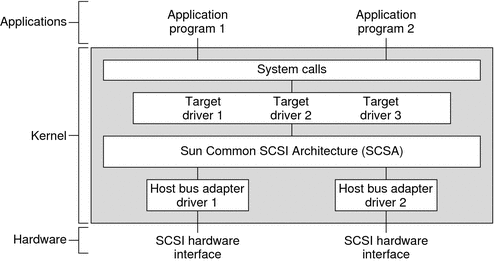|
|||||||||||||||||||||||||||||||||
|
Part I Designing Device Drivers for the Solaris Platform 1. Overview of Solaris Device Drivers 2. Solaris Kernel and Device Tree 5. Managing Events and Queueing Tasks 7. Device Access: Programmed I/O 10. Mapping Device and Kernel Memory 14. Layered Driver Interface (LDI) Part II Designing Specific Kinds of Device Drivers 15. Drivers for Character Devices Introduction to Target Drivers Declarations and Data Structures Autoconfiguration for SCSI Target Drivers Building and Transporting a Command 18. SCSI Host Bus Adapter Drivers 19. Drivers for Network Devices Part III Building a Device Driver 21. Compiling, Loading, Packaging, and Testing Drivers 22. Debugging, Testing, and Tuning Device Drivers 23. Recommended Coding Practices B. Summary of Solaris DDI/DKI Services C. Making a Device Driver 64-Bit Ready |
Sun Common SCSI Architecture OverviewThe Sun Common SCSI Architecture (SCSA) is the Solaris DDI/DKI programming interface for the transmission of SCSI commands from a target driver to a host bus adapter driver. This interface is independent of the type of host bus adapter hardware, the platform, the processor architecture, and the SCSI command being transported across the interface. Conforming to the SCSA enables the target driver to pass SCSI commands to target devices without knowledge of the hardware implementation of the host bus adapter. The SCSA conceptually separates building the SCSI command from transporting the command with data across the SCSI bus. The architecture defines the software interface between high-level and low-level software components. The higher level software component consists of one or more SCSI target drivers, which translate I/O requests into SCSI commands appropriate for the peripheral device. The following example illustrates the SCSI architecture. Figure 17-1 SCSA Block Diagram The lower-level software component consists of a SCSA interface layer and one or more host bus adapter drivers. The target driver is responsible for the generation of the proper SCSI commands required to execute the desired function and for processing the results. General Flow of ControlAssuming no transport errors occur, the following steps describe the general flow of control for a read or write request.
SCSA allows the execution of many of such operations, both overlapped and queued, at various points in the process. The model places the management of system resources on the host bus adapter driver. The software interface enables the execution of target driver functions on host bus adapter drivers by using SCSI bus adapters of varying degrees of sophistication. SCSA FunctionsSCSA defines functions to manage the allocation and freeing of resources, the sensing and setting of control states, and the transport of SCSI commands. These functions are listed in the following table. Table 17-1 Standard SCSA Functions
Note - If your driver needs to work with a SCSI-1 device, use the makecom(9F). |
||||||||||||||||||||||||||||||||
|